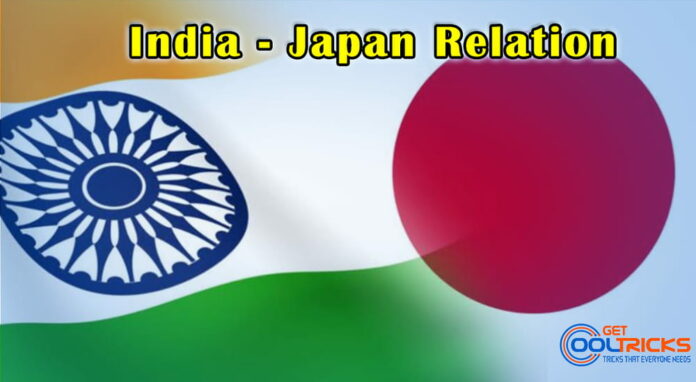Bilateral Relation
India- Japan Bilateral Relation PDF
- Within India: Japan has been a leading financial donor in the form of ODA (Official Development Assistance) to India.
- It continues to maintain a high degree of interest and support for India’s mega infrastructure projects like the Delhi-Mumbai Freight Corridor, Delhi-Mumbai Industrial Corridor, Chennai-Bangalore Industrial Corridor and the Ahmedabad-Mumbai High-Speed Rail
- Outside India: Asia-Africa Growth Corridor (AAGR) was announced in 2017 and joint projects in some third countries like Bangladesh, Myanmar, and Sri Lanka and in Africa as well will be taken jointly.
- Defence ties: Quadrilateral Security Dialogue is a strategic dialogue between India, United States, Japan and Australia will be carried out.
- Malabar exercise has been carried by India Japan and USA on a continuous basis.
- 2+2 dialogue at the defence and foreign minister level.
Defence Relation
India-Japan exchanges have strengthened due to growing convergence on strategic matters; and its significance is growing from the common outlook on issues of peace, security, and stability of the Indo-Pacific Region.
The Tri-Service Exchanges between Japan and India have been institutionalized completing the triad. Coast Guards have had regular annual exchanges since 2006.
Malabar 2019 was conducted off Western Kyushu in the Sea of Japan in September 2019. INS Sahyadri and INS Kiltan participated in the exercise
Economic Relation
- Japan is regarded as a key partner in India’s economic transformation.
- In the recent past, the India-Japan relationship has transformed into a partnership of great substance and purpose.
- Japan’s interest in India is increasing due to a variety of reasons including India’s large and growing market and its resources, especially human resources.
- Japan’s bilateral trade with India reached US$ 17.63 billion in FY 2018-19.
- India’s primary exports to Japan have been petroleum products, chemicals, elements, compounds, non-metallic mineral ware, fish & fish preparations, metalliferous ores & scrap, clothing & accessories, iron & steel products, textile yarn, fabrics, and machinery, etc.
- India’s primary imports from Japan are machinery, electrical machinery, iron and steel products, plastic materials, non-ferrous metals, parts of motor vehicles, organic chemicals, manufacturers of metals, etc.
India-Japan Digital Partnership (I-JDP) was launched during the visit of PM Modi to Japan in October 2018 furthering existing areas of cooperation as well as new initiatives within the scope of cooperation in S&T/ICT, focusing more on “Digital ICT Technologies”.
India-Japan Summit 2022
Reaffirming the Special Strategic and Global Partnership between India and Japan, the Prime Ministers concurred that the shared values and principles enunciated in the India-Japan Vision Statement issued in 2018 are particularly relevant in the present context, where global cooperation is required more than ever to address challenges that have become more acute.
Partnership for a free and open Indo-Pacific underpinned by Inclusiveness and Rules-based order:
Continuing bilateral and multilateral exercises including “Dharma Guardian” and “Malabar” respectively, while welcoming the participation of Japan for the first time in exercise MILAN, as well as making efforts to increase their complexity in the future.
Both countries affirmed the importance of bilateral and plurilateral partnerships among like-minded countries of the region, including the quadrilateral cooperation among Australia, India, Japan, and the United States (QUAD).
Japan welcomed the Indo-Pacific Oceans Initiative (IPOI) announced by Prime Minister Modi in 2019.
- The Prime Ministers acknowledged the growing space for cooperation between the IPOI and the Free and Open Indo-Pacific (FOIP).
- India appreciated Japan’s participation as a lead partner in the connectivity pillar of IPOI.
- They reiterated their strong support for ASEAN’s unity and centrality and their full support for the “ASEAN Outlook on the Indo-Pacific (AOIP)” which upholds the principles such as the rule of law, openness, freedom, transparency, and inclusiveness
India-Japan initiatives
Supply Chain Resilience Initiative (SCRI): Launched by India, Japan, and Australia to counter China’s dominance of the supply chain in the Indo-Pacific region.
Acquisition and Cross-Servicing Agreement (ACSA): India-Japan logistics agreement was signed in 2020 for the armed forces of both countries to coordinate closely in services and supplies.
Special Strategic and Global Partnership: Upgradation of India-Japan relation in 2014.
Comprehensive Economic Partnership Agreement (CEPA): India is the largest recipient of Japanese aid and Japan is India’s 12th largest trading partner.
India and Japan are common members of G 20, G 4, and the International Thermonuclear Experimental Reactor (ITER).
Defence Exercises
- JIMEX- bilateral naval exercise
- SHINYU Maitri- bilateral air force exercise
- Dharma Guardian- bilateral army exercise
- Malabar- QUAD naval exercise
Challenges
- Trade engagements have been below potential.
- On the list of countries that India exports to, Japan is in 18th position in the list of top 25 countries. On the list of countries importing into India, Japan ranks 12th.
- India’s exports to Japan in FY18 were lower than in FY15 in value terms.
- India struggling to penetrate the Japanese market as a result of language barriers, high quality and service standards.
- Negotiations to purchase amphibious US-2 planes have dragged on for years.
New Areas of Engagement
- A ‘Cool EMS Service’ was started, under which Japanese food items are transported in cool boxes from Japan to India through postal channels.
- Both sides are striving to push a digital partnership.
- Areas of potential collaboration include AI, IoT, and big data.
- India is likely to pitch for integration between the Ayushman Bharat project and the Japanese Asia Health and Wellbeing Initiative.


